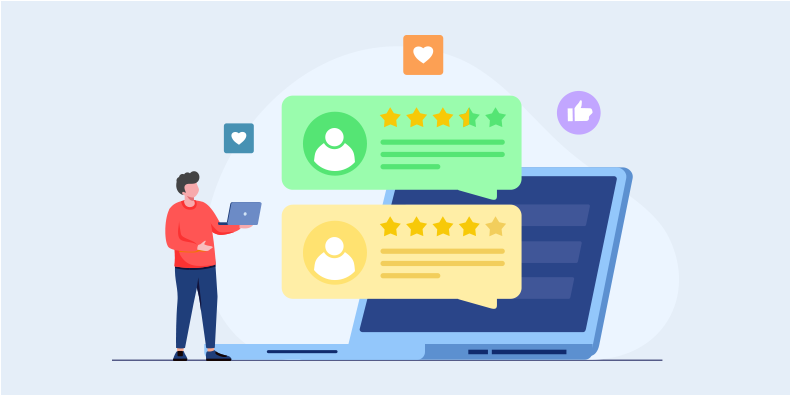Customer experience is undoubtedly the holy grail for businesses–it gets you higher revenue, a better brand reputation, more recommendations, and whatnot. However, Local customer experience should be viewed less as what it brings to the organization and more as how organizations can create a customer-first culture.
Having said that, when you think about scaling your customer experience efforts, localized experience optimization works in your favor. But how do you create a local customer experience, and where to begin?
According to Hubspot, 46% of all Google searches seek local information.
You can consider the following pointers when starting with your local customer experience endeavor.
> Checking your local listings on Google Maps or Apple Maps
> Online reviews on Google or an equivalent platform
> Easy payments and checkouts
You might wonder if investing in customer experience for your local audience would be worth it.
If yes, this statistic will change your mind.
94% of the customers say they have avoided a business entirely because of bad reviews.
Today’s article will walk you through a few strategies to improve the local customer experience for your business at scale. But first, let’s talk about the need to invest in local customer experience.
Local Customer Experience Matters
Building brand loyalty starts close to home when you begin to work on your local customer experience journey. Customers might even remember physical or real-life encounters with your brand. For example, they might have seen your store/outlet or heard about it from someone nearby.
Customers actively look for experiences closer to where they live for one simple reason–convenience. They might choose a local brand with a higher price than traveling miles away.
Do you know that 72% of consumers who did a local search visited a store within five miles?
That’s how crucial local customer experience has become lately.
However, your local customer experience can extend beyond just an offline physical presence that customers can access. It needs to penetrate your audience via other mediums they prefer, such as social media, text messages, and voice calls.
Let’s quickly move on to the strategies that can help you improve your local customer experience
1. Optimize your local customer experience with a standard Google Business profile and listings
When a customer is aware, he casually researches the product or service–whether through friends, family, or online. A typical customer’s journey begins when they search for your product or service online.
The SERP or Search Engine Result page shows the relevant results, and if you’re lucky, you’re in the top 10 results. The listing should have a few basic details, which should contain the following:
> The name of your business/outlet/store
> Exact address with landmark (if possible)
> A legitimate phone number or customer care number
> Working hours and off days
When customers come across your listing on Google SERP, they expect the information to be authentic.
Imagine how jarring it would be for them if they tried reaching you via calls and the number they call is either out of service or coverage, implying your company is no longer in business. Even a single wrong information field can create a bad customer impression, leading to a sub-standard local customer experience.
So, it’s imperative to nip the problem in the bud and ensure all the links and contact details are working, and the information is up to date.
However, to update this information at scale, you can take the help of local listing management to eliminate misinformation and ensure accurate details of your company across the entire web and search ecosystem.
Another essential platform to ensure you have correct brand information is voice calls. When we receive numerous spam calls throughout the day, it becomes mandatory for the brands to set themselves apart from the noise by establishing a unique brand identity for customers to resonate with.
Services like Truecaller for Business help you with precisely that. It adds a layer of brand authenticity and credibility to a business owner and allows your business to be perceived as a trustworthy brand. Moreover, a verified business caller ID helps improve your answer rate and overall brand reputation.
This is an essential solution from both perspectives–local customer experience and the customer experience in general.

2. Work on delivering a sophisticated level of customer service
Customers might get in touch with your customer service teams in two scenarios:
- If they have questions before actually making the purchase (discovery phase)
- Or if they have issues with the product after buying it (post-purchase phase
In either case, your customer service teams should be well-armed with the tools and solutions to assist customers with their queries as quickly as possible.
You might want to optimize chatbots, contact forms, and other messaging tools to deliver prompt and accurate customer service. If you wait to address customer complaints or concerns, you risk not meeting their expectations and a poor customer experience. One way to up your customer service game is by reducing the number of queries your customer might have by reducing the friction during their customer journey, which takes us to the next step of improving your local customer experience.
3. Create a frictionless purchase experience for your customers
Whether your customers are booking an appointment, filling out a contact us form, or checking out from a shopping cart–any friction in the flow can cause them to abandon the cart.
One way to ensure a frictionless customer experience across channels is to check if all your CTA buttons lead to the right landing page, the checkout process is short and easy to understand, and the number of steps to reach the end goal of buying is minimum.
Also, improving the speed of your website is essential to building a seamless flow for the customers and improving the local customer experience. Plus, pay attention to the design; create a logo that will resonate with the audience and be easy to add to your website since the logo is the visual face of your brand.
Moreover, you can also embed Google reviews and testimonials on your business website which leads the customers to trust your brand and purchase with confidence.
4. Reduce customer churn
Your customer experience doesn’t end when your customer buys the product. It is an opportunity to convert them into long-term loyal customers.
You can take the help of mediums like email campaigns targeted to your audience based on their personas. Furthermore, you can build a loyalty program for your customers who benefit by staying longer with you.
Also, providing in-depth product training, top-notch customer support, regular check-ins, and transparent communication reduces the chances of customer churn and elevates your customer experience.
5. Make it easy for customers to offer feedback
Feedback is the ultimate way to grow as a business and develop a customer-centric approach to solving problems. If your company offers a decent customer experience, customers may feel inclined to leave a positive review or feedback.
By offering a delightful customer experience, you can create a brand community of loyal supporters and advocates who defend your brand in your absence. They will eventually share their positive experiences with their friends and families, leaving positive word-of-mouth.
Moreover, feedback helps you identify your areas of improvement and brings out patterns that might need reframing from scratch.
To sum up:
Customer experience is a pillar of any successful business.
A firm grip on what customers need at every point of their buying journey is crucial to building a solid local customer experience. When businesses prioritize customers’ needs and experience, they’re better able to grow in a competitive market.
We help these strategies were helpful for you, and by implementing these, you will be better able to up your local customer experience game.


